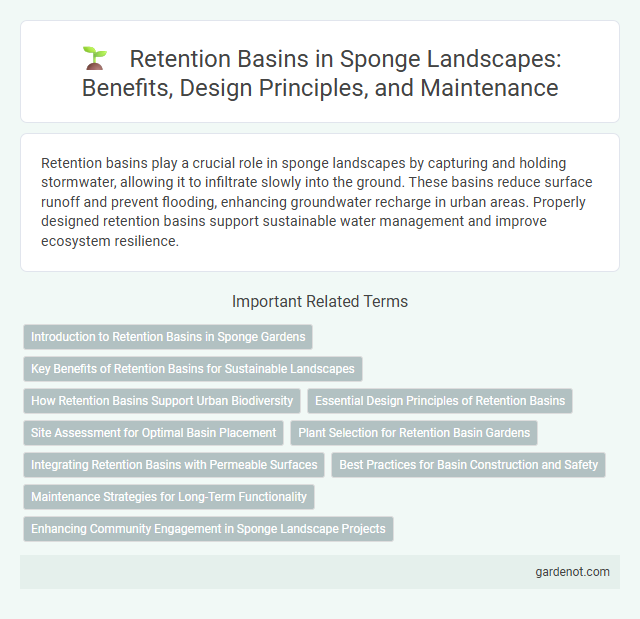Retention basins play a crucial role in sponge landscapes by capturing and holding stormwater, allowing it to infiltrate slowly into the ground. These basins reduce surface runoff and prevent flooding, enhancing groundwater recharge in urban areas. Properly designed retention basins support sustainable water management and improve ecosystem resilience.
Introduction to Retention Basins in Sponge Gardens
Retention basins in sponge gardens serve as crucial water management structures designed to capture and hold stormwater runoff, reducing flood risks and promoting groundwater recharge. These basins temporarily store excess water, allowing it to gradually infiltrate the soil and support surrounding vegetation, which enhances the garden's resilience against drought. Implementing retention basins improves urban sustainability by mitigating surface water pollution and optimizing the natural hydrological cycle within the landscape.
Key Benefits of Retention Basins for Sustainable Landscapes
Retention basins effectively manage stormwater by capturing and slowly releasing runoff, reducing flood risks and preventing soil erosion. They improve water quality through sedimentation and pollutant filtration, promoting healthier ecosystems in urban and suburban landscapes. These basins support groundwater recharge and increase biodiversity, making them vital for sustainable and resilient landscape design.
How Retention Basins Support Urban Biodiversity
Retention basins create essential habitats by holding stormwater and supporting diverse aquatic plants and wildlife, contributing to urban biodiversity. These basins help sustain local ecosystems by providing breeding grounds for amphibians, birds, and beneficial insects. Integrating retention basins in urban landscapes improves water quality and enhances the resilience of green infrastructure against environmental stressors.
Essential Design Principles of Retention Basins
Retention basins are engineered to manage stormwater by temporarily holding runoff and releasing it at controlled rates, reducing flood risk and promoting groundwater recharge. Key design principles include accurate calculation of basin volume based on watershed size and rainfall intensity, incorporation of sediment forebays to trap debris, and stable outlet structures to prevent erosion. Proper vegetation selection and basin slope optimization enhance infiltration and habitat value, ensuring long-term functionality and environmental benefits.
Site Assessment for Optimal Basin Placement
Site assessment for optimal retention basin placement involves analyzing soil permeability, topography, and drainage patterns to ensure effective water capture and infiltration. Evaluating existing hydrological data and potential runoff sources helps identify locations that maximize flood control and groundwater recharge. Careful consideration of environmental impact and land use compatibility further enhances the retention basin's efficiency in a sponge landscape.
Plant Selection for Retention Basin Gardens
Selecting appropriate plants for retention basin gardens enhances stormwater management by promoting infiltration and reducing runoff. Native grasses, sedges, and wetland species like Carex, Juncus, and Lobelia thrive in fluctuating water levels, stabilizing soil and improving water quality. Incorporating deep-rooted perennials such as Echinacea and Rudbeckia further supports erosion control and ecological resilience within retention basins.
Integrating Retention Basins with Permeable Surfaces
Retention basins enhance groundwater recharge when integrated with permeable surfaces by allowing stormwater to infiltrate slowly, reducing runoff and mitigating flooding risks. Combining these structures supports effective urban water management by promoting natural filtration processes and improving water quality. Permeable pavements surrounding retention basins increase infiltration rates, maximizing the basin's capacity to capture and store rainwater sustainably.
Best Practices for Basin Construction and Safety
Retention basins should be constructed with permeable soil layers and reinforced embankments to maximize water infiltration and prevent erosion. Incorporating safety features such as gentle side slopes, fencing, and clear signage reduces drowning risks and ensures public safety. Regular maintenance, including sediment removal and vegetation management, sustains basin functionality and enhances flood control efficiency.
Maintenance Strategies for Long-Term Functionality
Retention basins require regular inspection and sediment removal to maintain optimal water storage capacity and prevent clogging of outlet structures. Vegetation management is essential to control invasive species and promote native plant growth, which enhances filtration and erosion control. Implementing routine monitoring protocols ensures early detection of structural damage and supports timely repair, preserving long-term basin functionality.
Enhancing Community Engagement in Sponge Landscape Projects
Retention basins in sponge landscape projects serve as critical features for stormwater management, promoting groundwater recharge and flood mitigation. Engaging local communities through workshops and participatory planning increases awareness and stewardship of these green infrastructures. Collaborative efforts encourage maintenance and support, ensuring the long-term functionality and ecological benefits of retention basins within urban environments.
Retention basin Infographic

 gardenot.com
gardenot.com